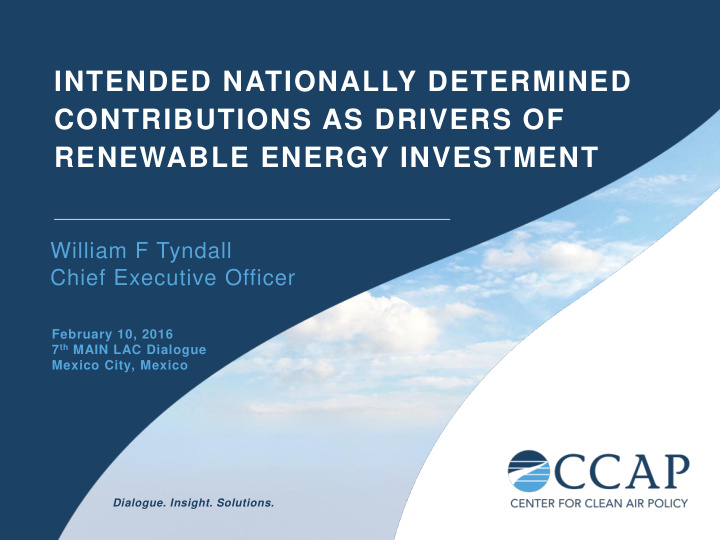



INTENDED NATIONALLY DETERMINED CONTRIBUTIONS AS DRIVERS OF RENEWABLE ENERGY INVESTMENT William F Tyndall Chief Executive Officer February 10, 2016 7 th MAIN LAC Dialogue Mexico City, Mexico Dialogue. Insight. Solutions.
ENERGY CHALLENGES • Aging power plants and distribution infrastructure • Changing customer expectations • One billion live without access to electricity • One billion people live with unreliable electricity • Climate goals require substantial decarbonization of electricity supply 1
GLOBAL PV MARKET CONTINUES TO GROW AS MORE COUNTRIES REACH RETAIL PARITY CCAP 2 Source: Duke Energy, CCAP Energy Dialogue, California, 2015
THE “DER” TRANSFORMATION Smart Cloud Computing Distributed Controls & & Communication Energy Resources Analytics Government support Low-cost sensors Data streaming 24/7 Scaling of Machine-to-machine Wi-Fi, broadband, 4G, manufacturing and controls 5G, XG installation Algorithm-based automation & mobile devices Electric cars 3 3
MANAGING ENERGY IN A BUILDING 4
STORAGE FOR COMMERCIAL CUSTOMERS • Demand management software combined with storage hardware • Automated demand reduction • Solar smoothing • Grid support 5
DISTRIBUTED ENERGY BENEFITS • Lower carbon emissions – Solar and energy efficiency = zero CO2 emissions – One study: Major California city could decrease carbon emissions by 70% by growing DER by 2% per year • System benefits – Reduced transmission losses – Grid Support – Greater resiliency • Cheap and clean electrification • Reduced Consumer Costs • Customer Choice 6
BUT BARRIERS REMAIN THAT MAY REQUIRE ADDRESSING AS PART OF INDC CONVERSION OECD 2011 The types and magnitude of barriers faced by a country will depend on their domestic fossil fuel resources and RE potential CCAP 7
INDC CONVERSION IS OPPORTUNITY TO IMPLEMENT EFFECTIVE POLICY THAT WILL DRIVE INVESTMENT RANGE OF POLICY OPTIONS TO PROMOTE RE • Financial Incentive Policies: – Feed-in Tariffs (FITs) – Tendering, reverse auctions – Tax policies – Net metering • Regulatory Policies – Renewable Portfolio/Clean Energy Standards – Cap & Trade, carbon pricing • Enabling environment for RE ideally should address on-grid, off-grid, and distributed generation as well as key barriers CCAP 8
TO OVERCOME BARRIERS, COUNTRIES HAVE STARTED TO SET TARGETS Global Renewable Energy Targets by Sector, 2005 - 2015 CCAP 9 Source: IRENA, Renewable Energy Target Setting, 2015
ADDING TARGETS TO THE INDC IS A GOOD WAY TO ATTRACT ATTENTION TO THE DOMESTIC MARKET Many countries mentioned RE targets in their INDCs: • China 800 GW by 2020 • India 175 GW by 2022 • Brazil 89% of power mix by 2030 - 23% non-hydro • Namibia 70% of power mix by 2030 • Vanuatu 65% of power mix by 2020,100% by 2030 Map: Countries which have submitted their INDC CCAP 10 Source: Map from World Resources Institute, CAIT Climate Data, 2015
SUCCESS STORIES: CALIFORNIA’S POLICY MIX Enabling environment – full range of policy actions over time • Ratcheting up RPS (utility procurement requirement) – 2002: 20% of retail sales from RE by 2017 – 2003: accelerated 20% deadline to 2010 – 2008: 33% RE by 2020 – 2015: 50% RE/clean energy by 2030 • Interconnection with neighboring states : allowing utilities to trade energy to balance out supply and demand fluctuations • Renewable Auction Mechanism : competitive bidding for DG projects 3-20 MW • Net Energy Metering : allows for compensation for excess generation • DG Goal : 12,000 MW by 2020 (5,200 MW of DG currently online) • CO2 cap and trade includes utilities : encourages utilities to shift toward RE, includes out-of-state power purchases CCAP 11
CALIFORNIA • CA has more than doubled installed RE capacity over the last four years, adding over 11,000 MW (out of 21,000 MW currently online) CCAP 12
GERMANY Renewable Energy development in Germany CCAP 13 Source: International Climate Initiative BMUB, CCAP Energy Dialogue, California, 2015
GERMANY Expansion of renewable energy sources in Germany CCAP 14 Source: International Climate Initiative BMUB, CCAP Energy Dialogue, California, 2015
SUCCESS STORIES: DENMARK AND DISTRIBUTED ENERGY • Denmark’s transition from central power stations (90% imported oil in 1980s) to distributed CHP (providing 47% of the country’s thermal electricity demand) and wind Source: Parbo, 2014. Energinet.dk. “Distributed Generation Trends and Regulation: The Danish Experience”. CCAP 15
SUCCESS STORIES: NICARAGUA'S MODEL BASED ON STRONG PRIVATE INVOLVEVEMENT AND INCENTIVES • Tax breaks and incentives for renewable energy developers • Set-asides in competitive tenders, with 10 year minimum contracts. • Open generation market : those without contracts can sell directly on the spot market • Reference prices for innovative renewable energy technologies set by government aim to boost competitiveness of clean energy sources • Renewable energy targets: 74% installed power capacity by 2018; 91% in 2027 CCAP 16
SUCCESS STORIES: NICARAGUA • $1.5B in renewable energy investment from 2006-2012 (5% of GDP) • Highest cumulative renewable energy investment relative to GDP in the region • Substantial non-hydro renewable energy capacity • No wind power in 2009 to 14% installed capacity in 2015 Sources: Climatescope, Bloomberg New Energy Finance; International Energy Association 17
THANK YOU For more information, please visit us at www.ccap.org.
Recommend
More recommend